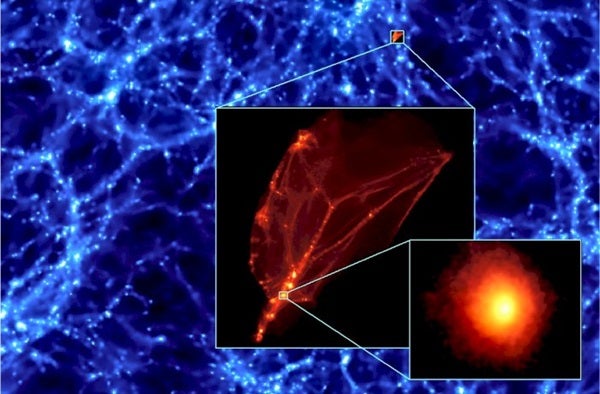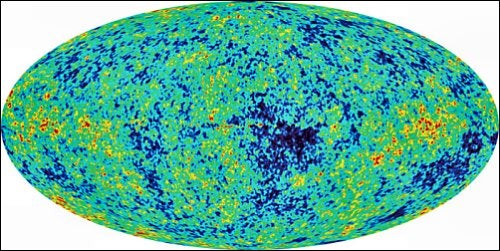A group of cosmologists has calculated the properties of the universe’s first structures. Juerg Diemand, Ben Moore, and Joachim Stadel at the Institute for Theoretical Physics of the University of Zürich in Zürich, Switzerland, simulated structural evolution beginning immediately after the Big Bang and followed the growth of structures to the present day. They found the first structures to form were Earth-mass, solar-system-size mini-halos of dark matter that formed after 20 million years.
In the past few years, cosmologists have made breakthroughs in the correlation between the cosmic microwave background (CMB) and the evolution of cosmic structure. The small patches of slightly different temperatures seen in the CMB correspond to fluctuations in mass density from when the universe was 350,000 years old. The mass-distribution fluctuations evolved — higher density attracts matter, lower density loses matter — into the large-scale structure scientists see today.
Dark matters
Dark matter is likely a combination of much cold dark matter (CDM) and a small amount of hot dark matter (HDM). “Cold” refers to slow-moving particles that could clump together early in the universe in the form of small structures. “Hot” particles move at high speeds and, therefore, first form large structures.
From CMB results and galactic-evolution modeling, the favored progression of structure formation is a result of more CDM than HDM. The initial dark-matter clumps attracted baryonic matter and, because of gravity, continued to clump together to create larger structures, eventually forming superclusters of galaxies.
Until the Zürich group’s computer simulation, cosmologists thought the first structures to form were galaxy-sized dark-matter clumps. Baryonic matter collapsed toward the center of the clumps, while dark matter remained as galactic halos; basically, there would be a “haze” of dark-matter particles encompassing a galaxy. The group found “the haze is not smooth, but all the mass is gathered into subclumps,” says Moore, “tiny halos with a mass similar to that of Earth but each as large as the entire solar system.”
The cosmologists based their calculations on the leading dark-matter candidate — a type of weakly interacting massive particle (WIMP) called a neutralino. Thought to have been created in the Big Bang, and predicted as an extension to the standard model of elementary particles, neutralinos have yet to be detected experimentally. The Large Hadron Collider, a particle accelerator being built at CERN in Switzerland, will find whether neutralinos — and other theorized supersymmetric particles — do exist.
The success of the Zürich group involved many months of calculations on the supercomputer they designed and built — zBox. Three hundred fast, AMD Athlon™ processors made it possible to study cosmic structure with more detail than ever. The group was able to look at the details of structural evolution within the galactic halo. They used “a multiscale technique in which smaller regions are simulated at higher resolution,” says Moore. What they found adds a finite scale to cosmic structure: mini-halos were the first structures in the universe to form.
Even more astonishing is the number of these objects in our galaxy. The group expects about 1015 mini-halos exist in our galactic halo, with one passing Earth every few thousand years. The mini-halos’ survival rate is high — with almost no mass loss. Close to the same number that initially formed are still floating in the galactic halo billions of years later.
Seeing the dark
How can scientists detect these substructure halos? It’s possible for a mini-halo to interact with baryonic matter as it passes through the solar system, although the chance of experiments detecting an interaction is low. Plus, the timing could be off by a few thousand years.
The most probable way to detect mini-halos of dark matter is to observe gamma rays from neutralino self-annihilation — when neutralinos collide, cancel each other out, and produce radiation.
“The gamma rays from neutralino annihilation will have a specific predicted energy,” says Moore. “The annihilation occurs in regions where the particle numbers are highest, which is at the very centers of these structures. The signal would be a slightly extended source in the sky.”
Even though gamma rays are the most energetic form of light, the signal “would still be difficult to detect, like trying to see the light of a single candle placed on Pluto,” says Diemand. However, future gamma-ray observatories will have the required sensitivity to observe signals from mini-halo interactions.
Of the laundry list of cosmological questions, one is now much closer to an answer.











